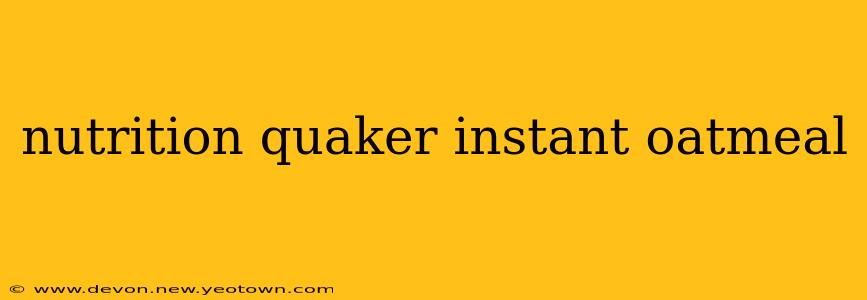Quaker Instant Oatmeal. The name conjures up images of cozy mornings, a quick breakfast, and perhaps… a slightly guilty feeling about nutritional value? Let's dispel that myth. While convenience is a major selling point, Quaker Instant Oatmeal, when prepared thoughtfully, can be a surprisingly nutritious part of a balanced diet. This isn't just about calories; it's about understanding the nutritional profile and making informed choices to maximize its health benefits.
What are the main nutritional benefits of Quaker Instant Oatmeal?
This is a question at the heart of many breakfast decisions. Quaker Instant Oatmeal's nutritional benefits stem primarily from its whole grain oats. These oats are a fantastic source of soluble fiber, a type of fiber that helps lower cholesterol levels and regulate blood sugar. This slow-releasing energy keeps you feeling fuller for longer, reducing cravings and potentially aiding in weight management. Beyond fiber, oats are also a good source of several essential vitamins and minerals, including iron, magnesium, and manganese. Remember, however, that the nutritional content can vary slightly depending on the specific flavor and preparation method.
How many calories are in a serving of Quaker Instant Oatmeal?
Calorie counts are often a primary concern. A single serving (typically 1/2 cup dry) of plain Quaker Instant Oatmeal contains roughly 150 calories. However, this number can change significantly depending on added ingredients. Sweetened varieties, for instance, will have more calories due to the added sugar. Adding milk, fruit, nuts, or sweeteners will also increase the overall calorie count. Always check the nutritional label on the specific product you are consuming for the most accurate information.
Is Quaker Instant Oatmeal good for weight loss?
The relationship between Quaker Instant Oatmeal and weight loss is complex. While the high fiber content promotes satiety, preventing overeating, the added sugars and fats in many flavored varieties can hinder weight-loss efforts. The key here is mindful consumption. Opt for plain oatmeal and add your own fruits, nuts, and spices to control the sugar and fat content. This approach allows you to customize your breakfast to fit your dietary goals while enjoying the benefits of the whole grains.
What are the potential downsides of eating Quaker Instant Oatmeal regularly?
While generally a healthy breakfast option, over-reliance on any single food can lead to nutritional imbalances. Regularly consuming Quaker Instant Oatmeal without sufficient variety in your diet might mean you're missing out on other essential nutrients. Additionally, some individuals might experience digestive discomfort due to the high fiber content, especially if they aren't used to consuming a lot of fiber. Starting with smaller portions and gradually increasing intake can help mitigate this issue. Finally, be aware of the added sugars and sodium in flavored varieties.
Can I eat Quaker Instant Oatmeal every day?
The question of daily consumption hinges on your overall diet. Including Quaker Instant Oatmeal as part of a varied and balanced diet is perfectly acceptable. However, relying solely on it for breakfast every day could lead to nutrient deficiencies over time. The best approach is to incorporate it strategically alongside other nutrient-rich foods, ensuring a diverse intake of vitamins, minerals, and other essential nutrients.
Is Quaker Instant Oatmeal healthy for diabetics?
Quaker Instant Oatmeal's high fiber content can be beneficial for managing blood sugar levels in individuals with diabetes. The slow release of carbohydrates prevents rapid spikes in blood glucose. However, it's crucial to choose plain, unsweetened varieties and avoid those with added sugars. Always consult with a doctor or registered dietitian for personalized dietary advice concerning diabetes management. They can help you integrate Quaker Instant Oatmeal safely and effectively into your diabetes meal plan.
In conclusion, Quaker Instant Oatmeal can be a healthy and convenient part of a balanced diet. By making informed choices about the flavor and additions, and by considering it as one component of a varied nutritional plan, you can reap its benefits while avoiding potential pitfalls. Remember to always read the nutritional labels and choose options that align with your individual dietary needs and goals.

